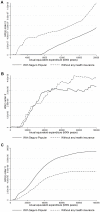Welfare effects of health insurance in Mexico: The case of Seguro Popular de Salud
- PMID: 29965976
- PMCID: PMC6028097
- DOI: 10.1371/journal.pone.0199876
Welfare effects of health insurance in Mexico: The case of Seguro Popular de Salud
Abstract
This study contributes with original empirical evidence on the distributional and welfare effects of one of the most important health policies implemented by the Mexican government in the last decade, the Seguro Popular de Salud (SPS). We analyze the effect of SPS on households' welfare using a decomposable index that considers insured and uninsured households' response to out-of-pocket (OOP) payments using both social welfare weights and inequality aversion. The disaggregation of the welfare index allows us to explore the heterogeneity of the SPS impact on households' welfare. We applied propensity score matching to reduce the self-selection bias of being SPS insured. Overall results suggest non-conclusive results of the impact of SPS on households' welfare. When we disaggregated the welfare index by different sub-population groups, our results suggest that households' beneficiaries of SPS with older adults or living in larger cities are better protected against OOP health care payments than their uninsured counterparts. However, no effect was found among SPS-insured households living in rural and smaller cities, which is a result that could be attributed to limited access to health resources in these regions. Scaling up health insurance coverage is a necessary but not sufficient condition to ensure the protection of SPS coverage against financial risks among the poor.
Conflict of interest statement
The authors have declared that no competing interests exist.
Figures



Similar articles
-
Heterogeneous effects of health insurance on out-of-pocket expenditure on medicines in Mexico.Value Health. 2012 Jul-Aug;15(5):593-603. doi: 10.1016/j.jval.2012.01.006. Epub 2012 Apr 12. Value Health. 2012. PMID: 22867767
-
Does the National Health Insurance Scheme provide financial protection to households in Ghana?BMC Health Serv Res. 2015 Aug 15;15:331. doi: 10.1186/s12913-015-0996-8. BMC Health Serv Res. 2015. PMID: 26275412 Free PMC article.
-
[The effect of Seguro Popular de Salud on catastrophic and impoverishing expenditures in Mexico, 2004-2012].Salud Publica Mex. 2018 Mar-Apr;60(2):130-140. doi: 10.21149/9064. Salud Publica Mex. 2018. PMID: 29738652 Spanish.
-
[Fair health financing and catastrophic health expenditures: potential impact of the coverage extension of the popular health insurance in Mexico].Salud Publica Mex. 2005;47 Suppl 1:S54-65. Salud Publica Mex. 2005. PMID: 16101207 Spanish.
-
Evaluating the impact of the national health insurance scheme of Ghana on out of pocket expenditures: a systematic review.BMC Health Serv Res. 2018 Jun 7;18(1):426. doi: 10.1186/s12913-018-3249-9. BMC Health Serv Res. 2018. PMID: 29879978 Free PMC article.
Cited by
-
Strategies for financing social health insurance schemes for providing universal health care: a comparative analysis of five countries.Glob Health Action. 2021 Jan 1;14(1):1868054. doi: 10.1080/16549716.2020.1868054. Glob Health Action. 2021. PMID: 33472557 Free PMC article. Review.
-
Improving the effective maternal-child health care coverage through synergies between supply and demand-side interventions: evidence from Mexico.J Glob Health. 2019 Dec;9(2):020433. doi: 10.7189/jogh.09.020433. J Glob Health. 2019. PMID: 32257178 Free PMC article.
-
Health care utilization for patients with stroke: a 3-year cross-sectional study of China's two urban health insurance schemes across four cities.BMC Public Health. 2021 Mar 18;21(1):531. doi: 10.1186/s12889-021-10456-x. BMC Public Health. 2021. PMID: 33736618 Free PMC article.
-
A systematic review of the literature on the impact of the Seguro Popular.Health Res Policy Syst. 2022 Apr 18;20(1):42. doi: 10.1186/s12961-022-00839-w. Health Res Policy Syst. 2022. PMID: 35436938 Free PMC article.
-
Equity in out-of-pocket health expenditure: Evidence from a health insurance program reform in Mexico.J Glob Health. 2023 Nov 24;13:04134. doi: 10.7189/jogh.13.04134. J Glob Health. 2023. PMID: 37994845 Free PMC article.
References
-
- Palmer N, Mueller D, Gilson L, Mills A, Haines A. Health financing to promote access in low income settings-how much do we know? Lancet [Internet]. 2004. October;364(9442):1365–70. Available from: http://www.sciencedirect.com/science/article/pii/S014067360417195X doi: 10.1016/S0140-6736(04)17195-X - DOI - PubMed
-
- Leive A, Xu K. Coping with out-of-pocket health payments: empirical evidence from 15 African countries. Bull World Health Organ [Internet]. 2008;86(11):849–56. Available from: http://www.who.int/bulletin/volumes/86/11/07-049403.pdf doi: 10.2471/BLT.07.049403 - DOI - PMC - PubMed
-
- Bank W. Poverty in Mexico: an assesment of conditions, trends and government strategy in Colombia and Mexico [Internet]. Washington, DC. USA: The World Bank; 2004. Available from: http://go.worldbank.org/XZGOGUSXZ0
-
- Xu K, Evans DB, Kawabata K, Zeramdini R, Klavus J, Murray CJL. Household catastrophic health expenditure: a multicountry analysis. Lancet [Internet]. 2003;362:111–7. Available from: doi: 10.1016/S0140-6736(03)13861-5 - DOI - PubMed
-
- Wagstaff A. Health systems in East Asia: what can developing countries learn from Japan and the Asian tigers? [Internet]. World Bank Policy Research. Washington DC. USA; 2005. (World Bank Policy Research Working Papers). Report No.: WPS3790. Available from: http://documents.worldbank.org/curated/en/864311468167373686/Health-syst... - PubMed
MeSH terms
Associated data
LinkOut - more resources
Full Text Sources
Other Literature Sources
Medical

